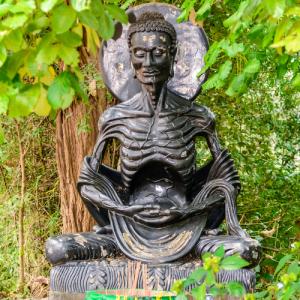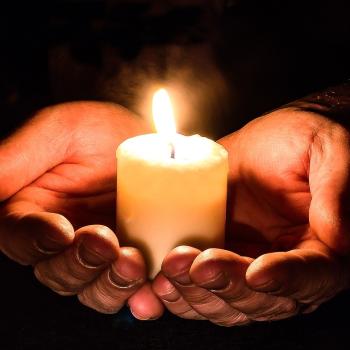Author’s note: this article is Part I of a chapter draft for an upcoming book with the working title: “Human Ascension.”

Since the dawn of abstract consciousness, there has been a tendency for we humans to conceive of the cosmos in which we live as being divided into two realms – the manifest world of immediate experience, and a more abstract, subtle, hidden, or mythic realm that somehow forms, shapes, or otherwise influences the mundane phenomenal world.
Perhaps the psychological motivations for this dualist view were the daily threats, fears, and struggles of mundane existence – and the longing for a state of being where such existential threats no longer exist. In any case, historically, visions of the latter often take the form of an idealized, spiritual realm, thought to be superior to the everyday world – one from which we have “descended” according to some philosophies, and one to which we may return upon our physical passing (i.e. “death”).
In other philosophies (Platonism for example), this higher realm is conceived not so much a destination but as simply an ideal template or “form” from which the phenomena of the manifest world are molded — generally with lesser perfection. (For example, we can imagine a perfect circle, yet according to Plato, every actual manifestation of a circle is imperfect if viewed with sufficient magnification.)
In either case, there is a frequent tendency to view the manifest world as inferior — a lesser, simpler, or degraded form. Sometimes temporal existence is considered to be a test or a training experience or even a punishment – a “vale of tears” — something to be endured as we move individually and collectively toward a more perfected state.
ASCETICISM
In the face of a mortal existence that is often frightening, disappointing or impoverished in some way, some seek to distance themselves from the experiential world and become wholly identified with a hoped-for future existence in the higher realm. Perhaps it is out of this duality that the practice of asceticism emerged in some religions and philosophies. Asceticism is essentially the denial or shunning or disparagement of worldly experience – especially pleasure – which is seen as an indulgence, and the embrace of a more minimalist lifestyle.
Perhaps the mildest form of asceticism lies in the Buddhist notions of egoless-ness and nonattachment. Pleasures might be enjoyed for their use-value if not for their symbolic ego-burnishing value. If a sought-for pleasure is denied, non-attachment means one can accept this outcome with reasonable equanimity.
More conventional forms of asceticism might simply consist of the avoidance of discretionary pleasures – exotic foods, fancy clothing, trappings of material wealth, frivolity, physical pleasure, experiences done simply for “fun”. Instead, material goods are sought and activities performed primarily for their practical value.
When asceticism is done as a religious/spiritual practice, there can be a tendency to look upon mortal existence with disdain and neglect as a means to “purify” one’s self – to become more “holy”. For example, in the popular book “Autobiography of a Yogi” (reportedly the only book Apple co-founder Steve Jobs kept on his iPhone), the author speaks with seeming fondness of saints in the state of advanced meditation with “lifeless and glassy eyes”, and he reasons that one would not pay homage to “a clod of clay” (the body). This appears to be an implicit turning away from mundane living experience.
Perhaps asceticism is most likely to become extreme, even pathological, when a compulsion exists to demonstrate commitment to the spiritual by excessive neglect, denial, denigration, even abuse, of physical existence – starvation, bizarre diet, self-flagellation/mutilation, exposure to environmental extremes, general neglect of basic health needs. In the early days of his explorations, Siddhartha Gautama (more commonly known as “The Buddha”) reportedly attempted to subsist on a single bean and a grain of rice per day. Others would engage in practices such as “the five fires” — mediating in the blazing sun, surrounded by bonfires. The animus side of human nature seems able to turn almost anything into an extreme sport. (“More ascetic than thou!”)
Yet if there is some overarching divine or evolutionary design for existence, would the denial of the same be its crowning achievement? Might there be a “middle path” for ascetic practice?
ASCETICISM 2.0
What is the core purpose of asceticism — the essential principle worthy of preservation? It is simply the avoidance of needless distractions and addictions that impede one’s growth and development and the realization of one’s full potential. This can be true whether one views life as a spiritual quest or as an entirely secular affair.
Such impediments might take the form of actual destructive behavior and attitude (e.g. alcoholism, hatred) or might simply be unconscious, unmindful, habitual activity, performed without immediate purpose, or performed for reasons other than the stated purpose (for example, have you ever eaten when not hungry?).
Healthy asceticism is simply about increasing the amount of time one maintains focus on the grand trajectory of one’s life, and having a clearer awareness of one’s motivations — all in support of keeping things moving in the direction of positive growth and development.
WORLDLY EXPERIENCE
Most of us would like to enjoy our time here on Earth, experience the best of what life has to offer, perhaps contribute to the human enterprise in some way, and generally to feel we’ve done the best we can with our lives. Most of us also likely understand the negative aspects of indulgence at its extremes.
On the one hand, the health impact and environmental consequences of over consumption are fairly clear for anyone willing to take an objective look. On the other hand, disease proneness, anorexia, social instability, and other problems illustrate the negatives of extreme deprivation. Somewhere between these poles, a balance, a middle path must be found.
So, what would a more balanced view of ascetic practice look like? What is its practical purpose and how might this change though the stages of one’s life? In the next article, we will consider some of the common pitfalls and illusions that impede psycho-spiritual development, and then look toward that which might further the same.












